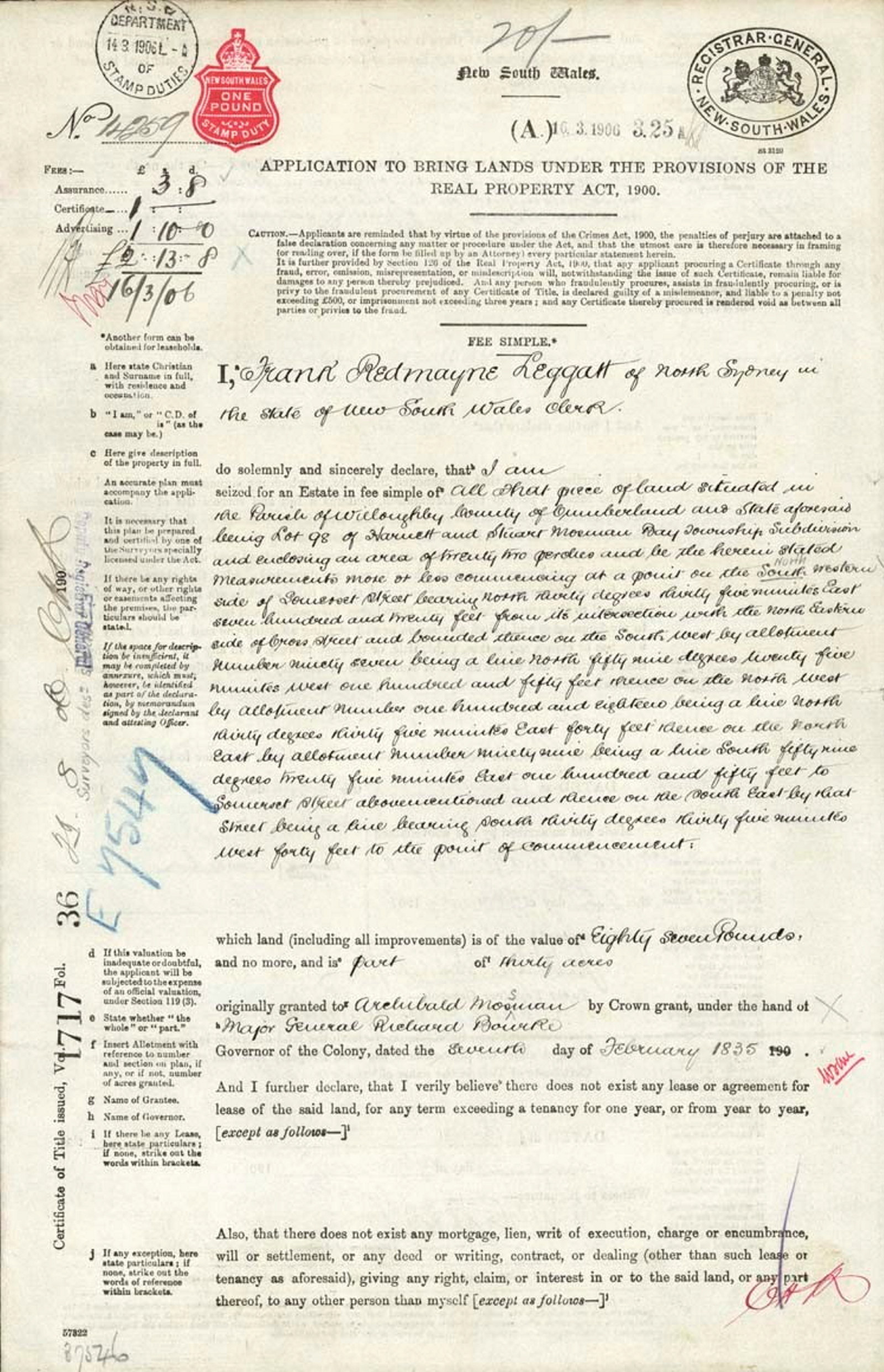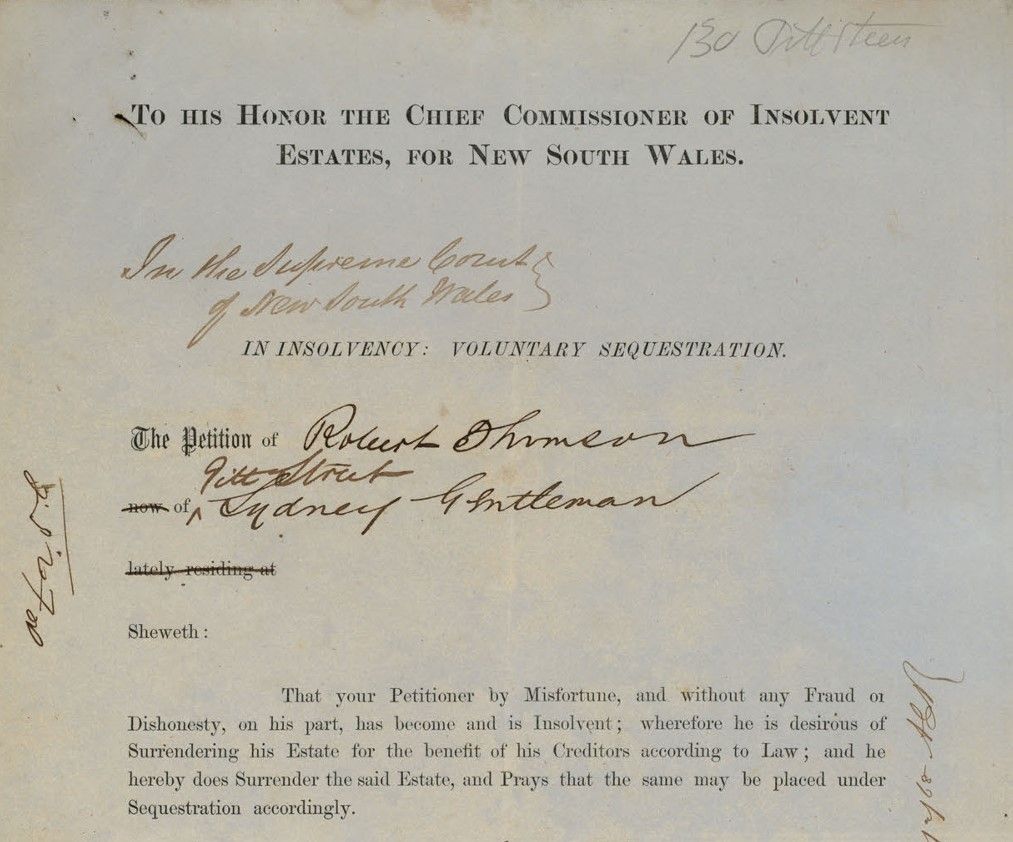COPY House & property guide
Historical house and property research can be complex and intricate without conveyancing expertise. This guide provides information on the historical house and property records in our collection, as well as other resources where you can find additional details.
Parish maps
Parish maps can often provide the original owner of the land on which the house was built, the size of the original block, the date that it was granted by or purchased from the Crown.
Record series
- NRS-8405 Cancelled parish, county, town, environs, municipality and area maps, 1880-1974
Digitised copies of parish maps
Available on the NSW Land Registry Services Historical Lands Records Viewer.
- See the NSW Land Registry Services website for further information about parish and historical maps.
Related

How to read a parish map
Parish maps function as indexes to land titling and land tenure records. This webinar shows you how to make sense of all of the details on a parish map

County & parish maps guide
An overview of county, parish and town/village maps created by the Department of Lands and its predecessors
Primary Applications
A primary application is made to convert land title from what is known as Old System title to registration under the provisions of the Real Property Acts (commonly referred to as Torrens Title).
Record series
- NRS-17513 Primary Application Packets, 1863+
Primary Application packets can contain:
- the survey plan
- correspondence, including Lands Department working papers and memos
- reports from the Title Examiner's and the Survey Draftsman
the draft Certificate of Title - caveats against the Application by adjoining owners or others claiming an interest in the land, and
- deeds, possibly including mortgages, and other dealings with the land.
Even if a packet contains documents relating to a primary application in respect of land in which you interested, it may not contain all the documents referred to in the application, particularly if the land was the result of one or more subdivisions.
Related

Primary application packets guide
The Real Property Act, 1862 established a system whereby owners could convert land granted prior to 1863 to Real Property Act title. This is done by what is called a Primary Application
Valuation records
Prior to 1919 the valuing of land was undertaken by local councils. From about 1919 this was gradually taken over by the Valuer General, starting with Manly in 1919 and reaching Broken Hill in the 1980's.
Record series
- NRS-14466 Valuation Cards, 1916-1927
These digitised cards provide information on the valuation of properties in the Sydney, Newcastle and Wollongong urban areas and many other urban areas throughout the State. Most cards start in the 1920s.
- NRS-14465, Valuation rolls, c.1928+
This series covers most areas of New South Wales. Information includes owner's name, address and occupation; lessee's name; address of property to be valued; nature of improvements; lot; area; value and remarks. The rolls are arranged by valuation district and within that by wards or ridings and then alphabetically by street. A detailed listing is available in the Reading Room.
- NRS-14467 Field books relating to property valuations (and cancelled Field book entries), c.1920-1978
Related

Land valuation guide
Land value refers to the monetary value of the land only and does not include the value of the home or other structures on the land
Survey sheets
Metropolitan Water Sewerage and Drainage Board
Record series
- NRS-9941 Detail Sheets, 1904-1945
A survey was usually done in preparation for a sewer and these survey sheets provide information about existing buildings which may include street name, house number and name, lot number, the outline of the ground floor and details of construction material. NRS-9942 should be consulted to locate the correct maps for a particular area.
Related
Metropolitan Water Sewerage & Drainage Board
An overview of the Detail Sheets created by the Metropolitan Water Sewerage and Drainage Board (MWS&DB) from c.1904 to 1945 and how to access them
Other property & asset records
To locate most of the records listed, you'll need the owner's name. These research guides offer detailed information to assist you.

Probate packets & wills guide
These records include the last will & testament. A grant of probate is the authority given by the Supreme Court of NSW to the executor(s) to deal with a deceased person's estate

Deceased estates guide
Deceased estate files are a financial record of the person's estate when they die and frequently have very detailed information about a person's possessions

Insolvency index 1842-1887
Insolvency is the inability to pay debts or meet expenses. Under early colonial law insolvency was treated as a different concept to bankruptcy (which involved an insolvents assets being administered and distributed to creditors)
More records
Police Records
If a murder or crime occurred in a house or property Police Gazettes 1862-c.1982 (NRS-10958) or related records may describe the house or property, as well as circumstances of the murder or crime. The police gazettes are indexed and can be searched by name of offender, house/property owners name, or location.
Police Gazettes 1862-1930 are available for searching on the Ancestry website.
Government Property Record
If a house or property was part of a government structure e.g. railway gatehouse, school building or police station, there may be relevant maps and plans, photographs or files. Search our catalogue under the name of station or school for associated records.
Records relating to occupants
Census Records
The census collectors' books provide street number (if used), name of head of household, and the number of people in the household divided by age and sex. Individuals' names are available only for the 1841, 1891 and 1901 censuses. They are arranged by town or suburb. See our Census and Musters Guide for more information.
Electoral Rolls
Electoral rolls can be useful for establishing where a person lived over a period of time. See our Electoral Rolls Guide for more information.
Sands Directory
The Sands Sydney Suburban and Country Directory 1858-1933 contains household and business information. It has been digitised by the City of Sydney Archives and is available for searching online.
Where else to find records
NSW Land Registry Services
NSW Land Registry Services (formerly LPI and the Department of Lands) maintains current and historic title records in a number of public registers.
The largest register is the Torrens Title register, introduced in 1863. Torrens titles are protected by State Government Guarantee and contain information in relation to current ownership and encumbrances on the land such as mortgages, leases and easements. Records are primarily about the land and do not indicate if there was a house on the land.
The General Register of Deeds was the first land registry in NSW established on 16 November 1825 under the Registration of Deeds Act 1825. It contains common law (old system) deeds for land transactions and incorporates the register of Causes Writs and Orders, Bills of Sale, Register of Resumptions, Powers of Attorney and all other miscellaneous deeds registered by the NSW LRS and its predecessors. See the NSW LRS website for information about Historical Records Online, Old System Land Titles and Parish and Historical Maps.
Since March 2006 access is electronic for all items entered in the General Register of Deeds since November 1992. You can search historical parish maps, Old Form Torrens Title Registers and Plan Lodgement Books using the NSW LRS Online Portal to access the Historical Land Records Viewer.
NSW LRS has a number of searching guides available on its website:
- First Stop Guide to the Records of the Registrar General (Mar 2013, PDF)
- Old System Information and Search Guide (Mar 2013, PDF)
- Searching the Registrar General's Maps and Plans (Mar 2013, PDF)
- Torrens Title Information and Search Guide (Mar 2013, PDF)
Crown Plans are available for viewing in our reading room on the HLRV. Crown plans can be purchased, over the counter at NSW LRS or through NSW LRS authorised Information Brokers
Local Council Records
The local council is a good source of information about the building of houses in the area. Before the Local Government Act of 1919, people did not have to apply for permission to build a house.
Where to find council records
The majority of council records are held by the relevant council. You will need to contact the council to access the records.
For a list of the council records we hold check State Archives catalogue for the name of the council and then look for the list of Created Series or Controlled Series. Council records from regional areas in NSW are often held at Regional Archives Centres. Check the series detail page for Repository - this will show you where the records are held.
The publication Local government - local history: a guide to NSW local government minute books and rate records edited by Joy Hughes, is available in the reading room and may also be of assistance in identifying the location of council records.
Rate and Valuation Books
Rate books and local valuation records can provide valuable information. We hold some of these in the NSW State Archives Collection.
What's in a rate book
Rate books primarily provide information on rates such as amount of rates due, amounts paid, arrears and when rates were abandoned.
Rate books can also provide a variety of other information including the location of buildings and other townscape features; the names of owners and occupiers of homes and businesses and evidence of former land use practices. The amount of detail provided can vary considerably from year to year.
How to use rate books
The books are divided into wards and within each ward the streets are listed alphabetically. Be aware that some streets have changed names and some have been renumbered. Knowing the estate name, lot and section number of a property is useful when using the rate and valuation records.
Development and Building Applications
Development and Building Applications provide the most basic evidence of property development within an area. We do not hold these in the NSW State Archives Collection. Before the Local Government Act of 1919, people did not have to apply for permission to build a house. Development and Building Applications mostly date from the 1920s.
In varying degrees of detail, these documents generally contain written design specifications as well as maps and plans relating to proposed property developments, including demolitions. They can contain applications for buildings, garages, fences, alterations and additions to structures.
Local studies collections
The local studies section of the local public library might also hold photographs, drawings, local history books and oral histories. Local newspapers and magazines might also include stories about the house or former residents.
Further Reading
Baskerville, Bruce, Historical research for heritage, Parramatta, NSW: NSW Heritage Office, 2000
Hughes, Joy N (ed.), Local government - local history: a guide to NSW local government minute books and rate records, Sydney, Royal Australian Historical Society, 1990
Irving, Robert, How old is my house, Royal Australian Historical Society technical information service leaflet no. 17, Sydney, Royal Australian Historical Society, 1988
Knight, Janet, 'Pieces in the puzzle', Vital Signs Magazine issue 4, March 2003, p. 10
Liston, Carol, Researching old buildings, Royal Australian Historical Society technical information service leaflet no. 4, Royal Australian Historical Society, 1986
Sagazio, Celestina (ed.), The National Trust research manual: trace the history of your house or other places Broadway, NSW, Halstead Press, 2004
Related

Researching your house and property
Learn how to find house and property records in the NSW State Archives Collection

Finding resources about the history of a house
Property records can be complex and confusing, but very rewarding. This webinar focuses on some key sources that can help to search for the history of a house

Dacey Garden Suburb
Daceyville, in Sydney's eastern suburbs, was built in 1912 to offer affordable housing for working-class families. This photo series shows the development of the suburb

Documenting NSW Homes
Recorded for the future: documenting NSW homes
The Caroline Simpson Library has photographically recorded homes since 1989